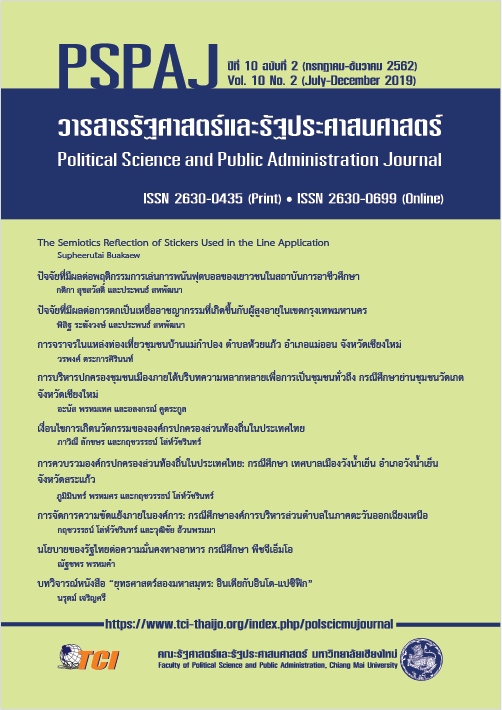Factors Affecting Football Gambling Behaviors among Youths in Vocational Education Institutions
Main Article Content
Abstract
This study was a study on factors affecting football gambling behaviors among youths in vocational education institutions in Bangkok. This study collected data from 382 youths studying in vocational institutions in Bangkok using questionnaire as a collecting tool. Multiple regression analysis was used for data analysis. The study found that social bonding has a negative effect whereas social learning has a positive effect on football gambling behavior among youths. It is suggested that we should focus on family and educational institutions to promote social bonding and to reduce the misuse of social learning regarding football gambling.
Article Details
- เนื้อหาและข้อมูลที่ลงตีพิมพ์ในวารสารรัฐศาสตร์และรัฐประศาสนศาสตร์ถือเป็นข้อคิดเห็นและความรับผิดชอบของผู้เขียนบทความโดยตรง ซึ่งกองบรรณาธิการวารสารรัฐศาสตร์และรัฐประศาสนศาสตร์ ไม่จำเป็นต้องเห็นด้วย หรือร่วมรับผิดชอบใดๆ
- บทความและข้อมูล ที่ได้รับการตีพิมพ์ในวารสารรัฐศาสตร์และรัฐประศาสนศาสตร์ ถือเป็นลิขสิทธิ์ของวารสาร หากบุคคลหรือหน่วยงานใดต้องการนำข้อมูลไปใช้ประโยชน์ในทางวิชาการ ขอให้อ้างอิงแหล่งที่มาด้วย
References
ศูนย์เทคโนโลยีสารสนเทศและกำลังคนอาชีวศึกษา. (2560). จำนวนนักเรียนแยกขนาดสถานศึกษา รัฐ, เอกชน ปีการศึกษา 2560. สืบค้นเมื่อ 18 มกราคม 2561, จาก https://techno.vec.go.th/ประชาสัมพันธ์/รายละเอียดข่าว/tabid/766/ArticleId/16298/language/th-TH/16298.aspx
ศูนย์วิจัยเพื่อการพัฒนาสังคมและธุรกิจ. (2559). โครงการสำรวจพฤติกรรมรับชมและการเล่นพนันทายผลฟุตบอลยูโร 2016. สืบค้นเมื่อ 10 ตุลาคม 2560, จาก https://www.gamblingstudy-th.org/document_research/136/7/4/survey-euro-2016/#!prettyPhoto
ศูนย์ศึกษาปัญหาการพนัน. (2559). การพนันในยุคเปลี่ยนผ่าน: รายงานประจำปี 2559 ศูนย์ศึกษาปัญหาการพนัน. กรุงเทพฯ: ศูนย์ศึกษาปัญหาการพนัน
สุจิตรา บุณยรัตพันธุ์. (2557). ระเบียบวิธีวิจัยสำหรับรัฐประศาสนศาสตร์. กรุงเทพฯ: เสมาธรรม.
Abbott, M.W. (2007). Situational Factors that Affect Gambling Behavior. In Smith, G., Hodgins, D., & Williams, R. (Eds.). Research and Measurement Issues in Gambling Studies. (pp. 251-278). New York: Elsevier.
Adams, G. R., Sullivan, A.-M., Horton, K. D., Menna, R., & Guilmette, A. M. (2007). A Study of Differences in Canadian University Students' Gambling and Proximity to a Casino. Journal of Gambling Issues, (19), 9-17.
Agnew, R. (1991). The Interactive Effects of Peer Variables on Delinquency. Criminology, 29(1), 47-72.
Akers, R. L. (1985). Deviant Behavior: A Social Learning Approach. Belmont: Wadsworth Publishing Company.
Braithwaite, J. (1989). Crime, Shame and Reintegration. Cambridge: Cambridge University Press.
Casey, D. M., Williams, R. J., Mossiere, A. M., Schopflocher, D. P., El-Guebaly, N., Hodgins, D. C., & et al. (2011). The Role of Family, Religiosity, and Behavior in Adolescent Gambling. Journal of Adolescence, 34(5), 841-851.
Casual Games Association. (2012). Social Casino Gaming 2012: Casual Games Sector Report. Smithfield, UT: Casual Games Association.
Cheung, N. W. (2016). Social Strain, Self-control, and Juvenile Gambling Pathology: Evidence from Chinese Adolescents. Youth & Society, 48(1), 77-100.
Dickson, L., Derevensky, J. L., & Gupta, R. (2008). Youth Gambling Problems: Examining Risk and Protective Factors. International Gambling Studies, 8(1), 25-47.
Gainsbury, S. M., Liu, Y., Russell, A. M., & Teichert, T. (2016). Is All Internet Gambling Equally Problematic? Considering the Relationship Between Mode of Access and Gambling Problems. Computers in Human Behavior, 55, 717-728.
Gainsbury, S. M., Russell, A., Blaszczynski, A., & Hing, N. (2015). The Interaction Between Gambling Activities and Modes of Access: A Comparison of Internet-only, Land-based Only, and Mixed-mode Gamblers. Addictive Behaviors, 41, 34-40.
Global Betting & Gaming Consultants. (2015). GBGC Global Gambling Report - 10th edition 2015. Retrieved October 10, 2017, from https://www.gbgc.com/news/gbgc-s-global-gambling-report-2015.
Gottfredson, M. R., & Hirschi, T. (1990). A General Theory of Crime. Washington, DC: Stanford University Press.
Hirschi, T. (1961). Causes of Delinquency. Berkeley, CA: University of California Press.
Inciardi, J. A., Horowitz, R., & Pottieger, A. E. (1993). Street Kids, Street Drugs, Street Crime: An Examination of Drug Use and Serious Delinquency in Miami. Belmont, CA: Wadsworth.
Lee, H.-S., Lemanski, J. L., & Jun, J. W. (2008). Role of Gambling Media Exposure in Influencing Trajectories Among College Students. Journal of Gambling Studies, 24(1), 25-37.
Lloyd, J., Doll, H., Hawton, K., Dutton, W. H., Geddes, J. R., Goodwin, G. M., & Rogers, R. D. (2010). Internet Gamblers: A Latent Class Analysis of their Behaviours and Health Experiences. Journal of Gambling Studies, 26(3), 387-399.
Lussier, I. D., Derevensky, J., Gupta, R., & Vitaro, F. (2014). Risk, Compensatory, Protective, and Vulnerability Factors Related to Youth Gambling Problems. Psychology of Addictive behaviors, 28(2), 404.
Lussier, I., Derevensky, J. L., Gupta, R., Bergevin, T., & Ellenbogen, S. (2007). Youth Gambling Behaviors: An Examination of the Role of Resilience. Psychology of Addictive behaviors, 21(2), 165.
Mishra, S., Templeton, A. J., & Meadows, T. J. (2017). Living, Fast and Slow: Is Life History Orientation Associated With Risk-related Personality Traits, Risk Attitudes, Criminal Outcomes, and Gambling?. Personality and Individual Differences, 117, 242-248.
Moghaddam, J. F., Yoon, G., Campos, M. D., & Fong, T. W. (2015). Social and Behavioral Problems among Five Gambling Severity Groups. Psychiatry research, 230(2), 143-149.
Pearce, J., Mason, K., Hiscock, R., & Day, P. (2008). A National Study of Neighbourhood access to Gambling Opportunities and Individual Gambling Behaviour. Journal of Epidemiology & Community Health, 62(10), 862-868.
Sarti, S. & Triventi, M. (2017). The Role of Social and Cognitive Factors in Individual Gambling: An Empirical Study on College Students. Social Science Research, 62, 219-237.
Takushi, R. Y., Neighbors, C., Larimer, M. E., Lostutter, T. W., Cronce, J. M., & Marlatt, G. A. (2004). Indicated Prevention of Problem Gambling Among College Students. Journal of Gambling Studies, 20(1), 83-93.
Toby, J. (1957). Social Disorganization and Stake in Conformity: Complementary Factors in the Predatory Behavior of Hoodlums. The Journal of Criminal Law, Criminology, and Police Science, 48(1), 12.
Wardle, H., Moody, A., Griffiths, M., Orford, J., & Volberg, R. (2011). Defining the Online Gambler and Patterns of Behaviour Integration: Evidence from the British Gambling Prevalence Survey 2010. International Gambling Studies, 11(3), 339-356.
Wills, T. A., Ainette, M. G., Stoolmiller, M., Gibbons, F. X., & Shinar, O. (2008). Good Self-control as a Buffering Agent for Adolescent Substance Use: An Investigation in Early Adolescence with Time-varying Covariates. Psychology of Addictive Behaviors, 22(4), 459-471.


